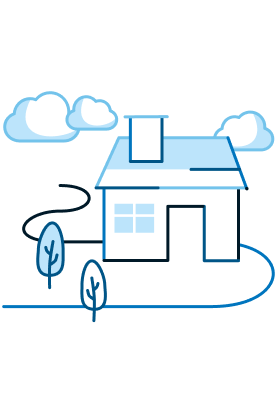A 2025 Guide to Down Payment Assistance Programs
We dive into down payment assistance programs: what’s available, who’s eligible, where and how to apply, and more.

Buying a home is a significant financial investment. However, in today's economic climate, making a down payment can be challenging. But what if you could receive assistance for your down payment?
What is down payment assistance?
Down payment assistance (DPA) programs are designed to help homebuyers afford some of the upfront costs of homeownership. These programs provide targeted financial support specifically for the down payment, which is the initial upfront portion of the total home purchase price that the buyer must pay, with the goal of making homeownership more accessible and financially feasible.
Down payment assistance is available through various channels, including government agencies, community organizations, and mortgage lenders. There are numerous DPA programs available, offering different types of assistance such as cash grants, lower mortgage rates, tax incentives, or repayable options.
To qualify for DPA, you will need to meet certain criteria. This often includes a minimum credit score, adhering to income limits, a healthy debt-to-income ratio, and for many programs, not having owned property in the previous three years.
Benefits of down payment assistance programs
Down payment assistance (DPA) programs can be a transformative resource for prospective homebuyers, making the aspiration of homeownership more attainable. Below, we explore some of the key advantages these programs offer.
Lower upfront costs
One of the most notable benefits of DPA programs is their ability to reduce the initial costs associated with purchasing a home. Potential homeowners are not limited to a single DPA program and can often combine multiple assistance options to maximize their benefits and reduce out-of-pocket expenses.
For instance, consider a first-time homebuyer aiming to purchase a $250,000 home. A 20% down payment is often recommended, which would come out to $50,000. By utilizing a DPA program that offers $20,000 in assistance, the required down payment is reduced to $30,000. If they layer additional assistance covering another $10,000, their out-of-pocket expense is further reduced to $20,000.
Reduces reliance on high-cost loans
Without sufficient savings for a down payment, many prospective buyers might resort to high interest loans and less favorable terms. DPA programs help buyers avoid these options by enabling them to secure more affordable and stable financing.
Promotes long-term financial stability
By making it easier to buy a home, DPA programs allow individuals to invest in property, build equity over time, and benefit from potential property value appreciation.
Encourages responsible borrowing and homeownership
Many DPA programs include educational components such as homebuyer counseling and financial literacy workshops. These resources empower buyers to make informed decisions, manage their finances responsibly, and maintain successful homeownership.

Types of down payment assistance programs
There’s a wide variety of DPA programs available, primarily tailored for first-time home buyers. For instance, BMO offers down payment assistance1 through Welcome Home Grants that can be used with first mortgage2 products like FHA3, Veterans Affairs4, Neighborhood Home Loan5, and more. Below are the most common types of assistance effective in helping prospective homeowners:
Grants
Grants are a popular choice since they do not require repayment. However, it's important to note that some grants might have specific conditions, such as residency requirements, that must be met to qualify. Unlike loans, grants are typically provided to lower the barrier of entry for homebuyers without adding to their long-term debt. Availability can vary based on factors like location, income level, and if this is the buyer’s first home.
Deferred-Payment Loans
Deferred-payment loans are financial assistance options that allow you to postpone repayment until specific conditions are met. Depending on the program, these conditions typically include the sale of the home, refinancing of the mortgage, or the mortgage reaching the end of its term. That said, buyers can always choose to repay the loan earlier.
During the deferment period, these loans generally have low or no interest rate. This type of loan can help bridge the gap for down payment costs without immediate financial pressure on the buyer. Buyers can even repay the low interest loan early to avoid accumulating interest. However, it’s crucial for the buyer to be prepared for repayment once the deferment period ends.
Forgivable Loans
A forgivable mortgage loan is a second mortgage that doesn’t require repayment, conditional upon you staying in your home or working for an employer for a set number of years. With an interest rate of 0% APR, forgivable loans are usually large enough to cover your down payment. Repayment is only required if you move, refinance, or sell your home before the forgiveness period ends.
Other DPA Programs
Various other down payment assistance programs are available, including property tax or closing cost credits, mortgage rate discounts, and matched savings programs. Of course, for every option, eligibility criteria will vary depending on the location, the lender and the prospective homebuyer.
Finding down payment assistance programs
Finding down payment assistance can significantly ease the path to homeownership. Start by exploring the resources available in your area. The U.S. Department of Housing and Urban Development (HUD) offers a comprehensive list of state-specific home buying programs. Search for grants or loan programs in your city that can provide the support you need.
It's also wise to check if your mortgage lender collaborates with any down payment assistance programs. Many financial institutions participate in such initiatives, with some even offering their own tailored assistance. For instance, BMO’s Low Down Payment initiative features a range of low down payment mortgage options and potential down payment assistance for qualifying home buyers.
Don't overlook the multitude of government programs available at the federal and municipal levels as well. Federal Housing Administration (FHA) loans are a prime example of a government-backed mortgage. State-run agencies also provide valuable resources; consider examples like the Illinois Housing Development Authority and the California Housing Finance Agency.
Common eligibility criteria for DPA
Once you've identified potential down payment assistance (DPA) programs, the key is to determine your eligibility. DPA programs can vary significantly but generally evaluate your income, the property's price, and your homeownership history. Remember, assistance is solely for primary residences and is not available for vacation homes or investment properties.
Here are some common requirements:
Income and credit score prerequisites: Most programs cater to low- to moderate-income individuals or those with less-than-ideal credit. Your household income must typically fall below a specific threshold.
Approved locations: Some programs limit eligibility to homes in certain areas.
Maximum home price: Properties sometimes must be below a specified price, often a percentage of the area's median home price.
Home-Buyer Education: First-time homebuyers often need to complete a HUD-certified home-buying course covering purchasing, responsibilities, and financial management.
While many DPA programs target first-time homebuyers, eligibility varies. Check the details of each program and verify that your lender is approved to ensure you qualify.
Consider this before applying for DPA
While DPA programs offer significant benefits for those struggling to meet down payment requirements, it’s important to be aware of potential drawbacks:
- Some DPA programs come with limitations and restrictions that may make it challenging for certain buyers to qualify.
- There are also additional costs associated with some assistance programs.
- There are often limits regarding the price, type, or location of the property you can purchase.
- DPA programs can sometimes create tax liabilities and affect your eligibility for other relief programs.
These factors may make DPA programs less appealing or even out of reach for some. However, alternative options exist for those who don’t qualify for DPA programs.
Alternatives to DPA programs if you don’t meet the requirements
Gifts from family: If your family is able to help, it can be beneficial in your home buying journey. Gifted money can be used for your down payment, helping you bridge the financial gap without taking on debt. Just make sure to provide a gift letter that states the funds are a gift and don’t need to be repaid, to comply with lender requirements.
Employer assistance: Check if your employer offers any homebuyer assistance benefits. These can come in the form of a grant or loan and might be part of a broader benefits package.
Seller assistance: Negotiating with the seller to cover some of the closing costs can be a win-win situation. This can free up funds that you can then apply toward your down payment.
Build your personal savings: Building your personal savings is a foundational strategy for home ownership. While it may take time, accumulating savings can provide you with a stronger financial footing. Consider using an affordability calculator6 to help determine saving targets and set realistic goals based on your financial situation.
These alternatives can provide viable options to help you achieve your goal of homeownership.
To recap
Securing a down payment is a significant milestone on your path to homeownership, but it's one that can be navigated with the right strategies and resources. Whether you're receiving gifts from family, leveraging personal savings, or exploring down payment assistance programs1, there are multiple avenues to make your dream home a reality.
Frequently Asked Questions
The time it takes to get down payment assistance depends on the program you choose and your circumstances. The best advice is to begin exploring your DPA options early, complete the homebuyers education course and organize your documentation.
Yes, you can use multiple down payment assistance programs, on condition that you meet the eligibility requirements for every program and that each allows for aid from other sources.
Depending on the program you may or may not have to pay back down payment assistance. Typically, you don’t have to repay a grant or tax credit, while forgivable loans are repayable only when certain conditions are not met.
Down payment assistance might affect how long it takes to complete closing. Delays - whether with the application, approval, underwriting or funding - can impact your closing timeline.
Who can apply for down payment assistance depends on the criteria of each program. While DPA programs are typically designed for first-time home buyers, some programs allow repeat buyers to apply too.
Ready to get started?
We’re ready to help with your homebuying journey, every step of the way.
Helpful tools
Related articles
Have questions?
1BMO offers affordable mortgage programs and works with government and community organizations that offer down payment and closing cost assistance. The availability and amount of down payment and closing cost assistance varies based on income and property location.
2Relationship Requirement: If the property is not located in the following locations; AZ, CA, CO, FL, ID, IL, IN, IA, KS, MN, MO, NE, NV, NM, ND, OK, OR, SD, UT, WA, WI, WY, and EL Paso County, TX (Home Equity is not available in Texas) to be eligible for our real estate secured lending products, you must be a pre-existing BMO customer for at least six months at the time of application; contact a Banker for details. A BMO customer relationship includes any deposit, retirement, small business, secured and unsecured credit, and investment accounts (BMO Alto accounts are excluded). Not applicable to our Private Bank clients or BMO employees.
3FHA mortgage loans are available for owner-occupied 1-4 unit primary residences located nationwide except refinances in Texas.
4Veterans, Servicemembers, and members of the National Guard or Reserve may be eligible for a loan guaranteed by the U.S. Department of Veteran Affairs (VA). A Certificate of Eligibility (COE) from the VA is required to document eligibility. Restrictions and limitations apply.
5Neighborhood Home Loan Product may be subject to other restrictions and is available to borrowers buying or refinancing properties located in low to moderate income census tracts in select counties in AZ, CA, CO, FL, ID, IL, IN, IO, KS, MN, MO, NE, NV, NM, ND, OK, OR, SD, UT, WA, WI and WY.
6Calculator is provided by Leadfusion Inc., which is not affiliated with BMO. The calculator provides estimates. We do not guarantee their accuracy or applicability to your circumstances. Results depend on many factors, including the assumptions you provide. Leadfusion may have different privacy and security standards than BMO. Visit its website at www.leadfusion.com to review its privacy policy.
Accounts are subject to approval and are provided in the United States by BMO Bank N.A. Member FDIC




